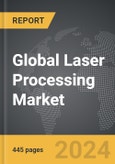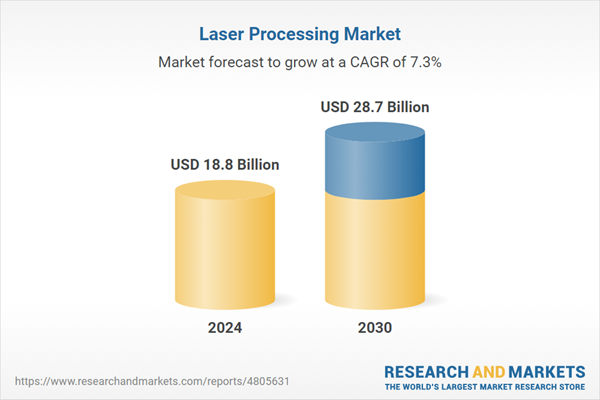The global market for Laser Processing was valued at US$18.8 Billion in 2024 and is projected to reach US$28.7 Billion by 2030, growing at a CAGR of 7.3% from 2024 to 2030. This comprehensive report provides an in-depth analysis of market trends, drivers, and forecasts, helping you make informed business decisions. The report includes the most recent global tariff developments and how they impact the Laser Processing market.
The ongoing advancement in laser processing is significantly driven by continuous innovations in laser technology and materials science. Developments in fiber lasers, disk lasers, and ultra-short pulse lasers have expanded the boundaries of laser processing applications. For example, ultra-short pulse lasers allow for the processing of materials without causing heat damage, opening new opportunities in the medical devices and semiconductor industries. These lasers can create precise incisions and patterns essential for medical implants and microchip manufacturing, where traditional mechanical processing methods might fail. Furthermore, the integration of automation and AI with laser processing systems has led to the development of smarter, more adaptive processing solutions. These systems can automatically adjust parameters in real-time for optimized performance, reducing waste and energy consumption. The push towards Industry 4.0, characterized by the integration of IoT, real-time data monitoring, and interconnected production systems, further enhances the capabilities of laser processing equipment, making it a key player in the future of smart manufacturing.
The growth in the laser processing market is driven by several factors, including technological advancements, increased adoption across diverse industries, and evolving global manufacturing trends. As industries continue to seek more efficient, precise, and cost-effective manufacturing methods, laser technology is often at the forefront of these transitions. The automotive and aerospace sectors, for example, utilize laser processing for lightweighting vehicles and aircraft, which involves reducing the weight of parts to enhance fuel efficiency without compromising strength or safety. Additionally, the rise in global consumer electronics consumption demands high-speed, high-precision manufacturing processes for components like printed circuit boards and smartphone parts, areas where laser processing excels. Consumer behavior trends towards personalized and customized products have also spurred the use of laser processing in creating bespoke items. Furthermore, environmental regulations pushing for reduced waste and lower energy consumption in industrial production stimulate interest in laser technologies, which are inherently more resource-efficient than many traditional manufacturing processes. These drivers collectively ensure the continued expansion and relevance of the laser processing market in the global manufacturing landscape.
Segments: Type (Solid, Liquid, Gas, and Other Types); and Vertical (Machine Tools, Medical & Life Sciences, Automotive, Aerospace & Defense, Architecture, and Other Verticals).
Geographic Regions/Countries: World; United States; Canada; Japan; China; Europe (France; Germany; Italy; United Kingdom; and Rest of Europe); Asia-Pacific; Rest of World.
The analysts continuously track trade developments worldwide, drawing insights from leading global economists and over 200 industry and policy institutions, including think tanks, trade organizations, and national economic advisory bodies. This intelligence is integrated into forecasting models to provide timely, data-driven analysis of emerging risks and opportunities.
Global Laser Processing Market - Key Trends & Drivers Summarized
Laser processing technology is a cornerstone of modern manufacturing, known for its precision, speed, and versatility in cutting, marking, engraving, and welding a wide range of materials. This technology harnesses the power of highly focused laser beams to achieve fine detailing and high-quality finishes that are crucial in industries such as electronics, automotive, and aerospace. Lasers are particularly valued for their ability to process complex parts with minimal physical contact, which reduces the risk of material deformation and enables the processing of delicate and temperature-sensitive materials. Additionally, laser processing is renowned for its efficiency in batch production and custom fabrication, making it indispensable for applications ranging from micro-scale electronic components to large-scale metal structures. Moreover, laser technology continues to evolve, integrating with other manufacturing processes to create hybrid techniques that enhance capability and resource efficiency, such as laser-assisted machining and laser-aided additive manufacturing.The ongoing advancement in laser processing is significantly driven by continuous innovations in laser technology and materials science. Developments in fiber lasers, disk lasers, and ultra-short pulse lasers have expanded the boundaries of laser processing applications. For example, ultra-short pulse lasers allow for the processing of materials without causing heat damage, opening new opportunities in the medical devices and semiconductor industries. These lasers can create precise incisions and patterns essential for medical implants and microchip manufacturing, where traditional mechanical processing methods might fail. Furthermore, the integration of automation and AI with laser processing systems has led to the development of smarter, more adaptive processing solutions. These systems can automatically adjust parameters in real-time for optimized performance, reducing waste and energy consumption. The push towards Industry 4.0, characterized by the integration of IoT, real-time data monitoring, and interconnected production systems, further enhances the capabilities of laser processing equipment, making it a key player in the future of smart manufacturing.
The growth in the laser processing market is driven by several factors, including technological advancements, increased adoption across diverse industries, and evolving global manufacturing trends. As industries continue to seek more efficient, precise, and cost-effective manufacturing methods, laser technology is often at the forefront of these transitions. The automotive and aerospace sectors, for example, utilize laser processing for lightweighting vehicles and aircraft, which involves reducing the weight of parts to enhance fuel efficiency without compromising strength or safety. Additionally, the rise in global consumer electronics consumption demands high-speed, high-precision manufacturing processes for components like printed circuit boards and smartphone parts, areas where laser processing excels. Consumer behavior trends towards personalized and customized products have also spurred the use of laser processing in creating bespoke items. Furthermore, environmental regulations pushing for reduced waste and lower energy consumption in industrial production stimulate interest in laser technologies, which are inherently more resource-efficient than many traditional manufacturing processes. These drivers collectively ensure the continued expansion and relevance of the laser processing market in the global manufacturing landscape.
Report Scope
The report analyzes the Laser Processing market, presented in terms of units. The analysis covers the key segments and geographic regions outlined below.Segments: Type (Solid, Liquid, Gas, and Other Types); and Vertical (Machine Tools, Medical & Life Sciences, Automotive, Aerospace & Defense, Architecture, and Other Verticals).
Geographic Regions/Countries: World; United States; Canada; Japan; China; Europe (France; Germany; Italy; United Kingdom; and Rest of Europe); Asia-Pacific; Rest of World.
Key Insights:
- Market Growth: Understand the significant growth trajectory of the Solid segment, which is expected to reach US$18.7 Billion by 2030 with a CAGR of a 7.7%. The Liquid segment is also set to grow at 6.8% CAGR over the analysis period.
- Regional Analysis: Gain insights into the U.S. market, valued at $3.6 Billion in 2024, and China, forecasted to grow at an impressive 9.5% CAGR to reach $7.7 Billion by 2030. Discover growth trends in other key regions, including Japan, Canada, Germany, and the Asia-Pacific.
Why You Should Buy This Report:
- Detailed Market Analysis: Access a thorough analysis of the Global Laser Processing Market, covering all major geographic regions and market segments.
- Competitive Insights: Get an overview of the competitive landscape, including the market presence of major players across different geographies.
- Future Trends and Drivers: Understand the key trends and drivers shaping the future of the Global Laser Processing Market.
- Actionable Insights: Benefit from actionable insights that can help you identify new revenue opportunities and make strategic business decisions.
Key Questions Answered:
- How is the Global Laser Processing Market expected to evolve by 2030?
- What are the main drivers and restraints affecting the market?
- Which market segments will grow the most over the forecast period?
- How will market shares for different regions and segments change by 2030?
- Who are the leading players in the market, and what are their prospects?
Report Features:
- Comprehensive Market Data: Independent analysis of annual sales and market forecasts in US$ Million from 2024 to 2030.
- In-Depth Regional Analysis: Detailed insights into key markets, including the U.S., China, Japan, Canada, Europe, Asia-Pacific, Latin America, Middle East, and Africa.
- Company Profiles: Coverage of players such as II-VI, Inc., Amada Co., Ltd., IPG Photonics Corporation, ESAB Group (UK) Ltd., Amada Co,. Ltd. and more.
- Complimentary Updates: Receive free report updates for one year to keep you informed of the latest market developments.
Some of the 96 companies featured in this Laser Processing market report include:
- II-VI, Inc.
- Amada Co., Ltd.
- IPG Photonics Corporation
- ESAB Group (UK) Ltd.
- Amada Co,. Ltd.
- Ewag AG
- Bystronic, Inc.
- Concept Laser GmbH
- Control Micro Systems (CMS)
- Epilog Laser, Inc.
- Eurolaser GmbH
- Bystronic Laser AG
- Han's Laser Technology Industry Group Co., Ltd.
- ALLTEC GmbH - Foba
- Alpha Cnc Group Pty Limited
Tariff Impact Analysis: Key Insights for 2025
Global tariff negotiations across 180+ countries are reshaping supply chains, costs, and competitiveness. This report reflects the latest developments as of April 2025 and incorporates forward-looking insights into the market outlook.The analysts continuously track trade developments worldwide, drawing insights from leading global economists and over 200 industry and policy institutions, including think tanks, trade organizations, and national economic advisory bodies. This intelligence is integrated into forecasting models to provide timely, data-driven analysis of emerging risks and opportunities.
What’s Included in This Edition:
- Tariff-adjusted market forecasts by region and segment
- Analysis of cost and supply chain implications by sourcing and trade exposure
- Strategic insights into geographic shifts
Buyers receive a free July 2025 update with:
- Finalized tariff impacts and new trade agreement effects
- Updated projections reflecting global sourcing and cost shifts
- Expanded country-specific coverage across the industry
Table of Contents
I. METHODOLOGYII. EXECUTIVE SUMMARY2. FOCUS ON SELECT PLAYERSIII. MARKET ANALYSISIV. COMPETITION
1. MARKET OVERVIEW
3. MARKET TRENDS & DRIVERS
4. GLOBAL MARKET PERSPECTIVE
UNITED STATES
CANADA
JAPAN
CHINA
EUROPE
FRANCE
GERMANY
ITALY
UNITED KINGDOM
REST OF EUROPE
ASIA-PACIFIC
REST OF WORLD
Companies Mentioned (Partial List)
A selection of companies mentioned in this report includes, but is not limited to:
- II-VI, Inc.
- Amada Co., Ltd.
- IPG Photonics Corporation
- ESAB Group (UK) Ltd.
- Amada Co,. Ltd.
- Ewag AG
- Bystronic, Inc.
- Concept Laser GmbH
- Control Micro Systems (CMS)
- Epilog Laser, Inc.
- Eurolaser GmbH
- Bystronic Laser AG
- Han's Laser Technology Industry Group Co., Ltd.
- ALLTEC GmbH - Foba
- Alpha Cnc Group Pty Limited
Table Information
| Report Attribute | Details |
|---|---|
| No. of Pages | 445 |
| Published | April 2025 |
| Forecast Period | 2024 - 2030 |
| Estimated Market Value ( USD | $ 18.8 Billion |
| Forecasted Market Value ( USD | $ 28.7 Billion |
| Compound Annual Growth Rate | 7.3% |
| Regions Covered | Global |









